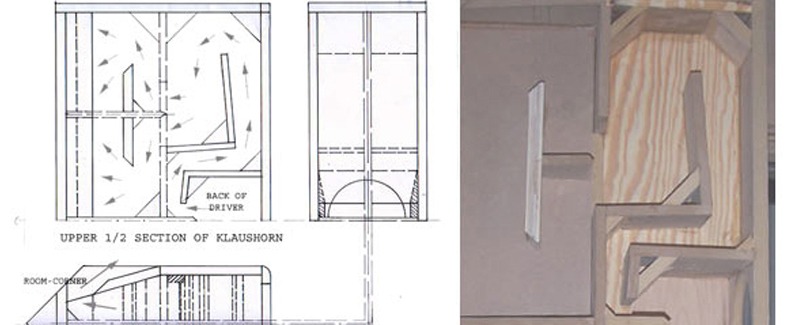The advantage of a Cornerhorn is well known (Klipschhorn) I wanted to downsize
the Cabinet . I used a combination Bush and Klipsch horndesign to achieve the
best possible output. I used the Dayton Audio PS180-8 and the a Fostex 166en
and the sound was pleasing.
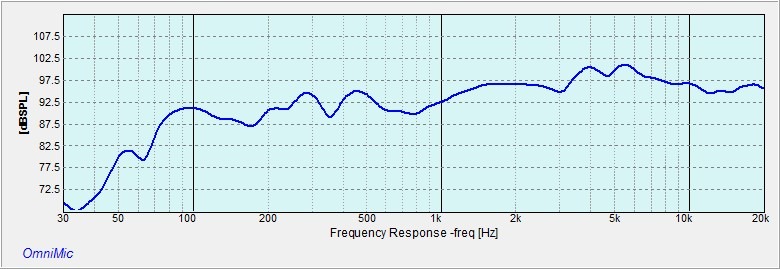
The Cabinet is not an easy build some 50 some odd pieces but where there is a
will there's a way, right? The Img. below shows the accustic operation.
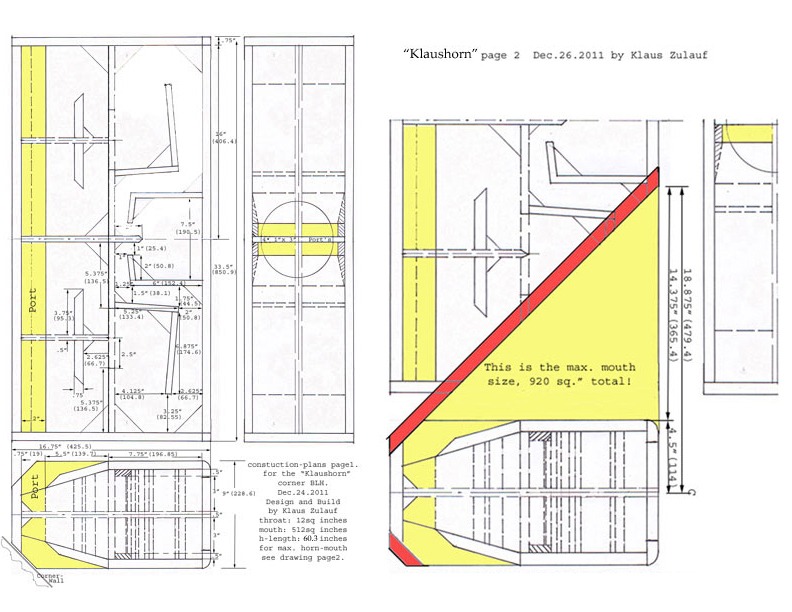
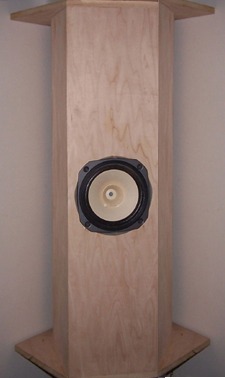
I call it the Klaushorn, why not!
Any thoughts?
the Cabinet . I used a combination Bush and Klipsch horndesign to achieve the
best possible output. I used the Dayton Audio PS180-8 and the a Fostex 166en
and the sound was pleasing.

The Cabinet is not an easy build some 50 some odd pieces but where there is a
will there's a way, right? The Img. below shows the accustic operation.


I call it the Klaushorn, why not!
Any thoughts?
Last edited:
The back of the driver radiates from the 12 sq.in to the port of 512 sq.in. With the default design, where the port size would be 8"wide*2sides*32"high=512. This makes the cabinet a very compact back loaded corner Horn. However lets not forget that by placing the cabinet in the corner the size decreases, apose to the free air placement size would be 8 times bigger. We can only point out all gains and losses, the final choice you need to make for your Application of the Klaushorn, and if needed we can help to make this decision.


Looks very handsome.
Klipsch was very attached to the notion of having a smallish sealed box behind of the driver (and a small aperture for the front). But the only way to have a sealed box and be full-range is to have all the notes, bottom to top, come around through the folded horn.
Perhaps those who favor full-range design AND horns, should think about getting the treble out through a folded horn.
For the moment, I can't think why the whole audio design world dismisses the idea of sending the treble through a folded horn??? Might need a little EQ. It should have the same charms as sending the bass out into the room that way. Doesn't seem esp. problematic?
Ben
Klipsch was very attached to the notion of having a smallish sealed box behind of the driver (and a small aperture for the front). But the only way to have a sealed box and be full-range is to have all the notes, bottom to top, come around through the folded horn.
Perhaps those who favor full-range design AND horns, should think about getting the treble out through a folded horn.
For the moment, I can't think why the whole audio design world dismisses the idea of sending the treble through a folded horn??? Might need a little EQ. It should have the same charms as sending the bass out into the room that way. Doesn't seem esp. problematic?
Ben
Last edited:
Klipsch was very attached to the notion of having a smallish sealed box behind of the driver (and a small aperture for the front).
Those are called front loaded [bass] horns.
For the moment, I can't think why the whole audio design world dismisses the idea of sending the treble through a folded horn??? Might need a little EQ. It should have the same charms as sending the bass out into the room that way. Doesn't seem esp. problematic?
Ha! Not especially problematic? I wish. 99% of speaker designers for the past 8 decades have wished the same too.
Why not use a folded bass horn full-range? Simple: the folding causes significant attenuation of mids & HF, along with severe phase &c. issues from internal reflections. The LF wavelengths aren't especially bothered about this, since they're too long to be significantly disturbed. Some people, like myself, actually design the folding scheme to be a functional part of the low-pass filter in back-horn designs (you really don't want mids / HF coming through the horn in those
The Karlson boxes sort-of follow this criteria, but they're rmore 4 - 8 order BP than horns per se. Related, but not quite the same. Dredging though what's left of my mind for examples in audio history, I suspect the closest approach was the original Lowther-Voigt corner horn, which used a back-loaded bass horn, while the front fired into reflectors which dispersed the mids & HF into the room. This indirect radiation of the upper registers was primarily a means of dealing with the significant peaking of the early Lowther drive units. Voigt had a handful of other types too in his patents; none would have offered all that distinguished a mid & HF performance though. There may be some other examples from WE etc., although I can't recall any off the top of my head.
Last edited:
All right, no argument from me, and that's conventional wisdom (I'm not using "conventional" in its usual pejorative sense). For sure, lowpass feature may have helped keep noise out of bass horn output in front loaded horns.
Of course until recently, it was conventionally accepted that no OB would produce useful bass below 100 Hz, once you did the wave arithmetic.
But my agreement does not extend to the inexorable logic of comb filters and other phase effects that are perfectly damaging in theory but not in hearing.
I'd like to see somebody put a mid-to-treble driver deep in a folded horn and see what comes out. Who knows, on music, might be luscious spacious sound.
Ben
Of course until recently, it was conventionally accepted that no OB would produce useful bass below 100 Hz, once you did the wave arithmetic.
But my agreement does not extend to the inexorable logic of comb filters and other phase effects that are perfectly damaging in theory but not in hearing.
I'd like to see somebody put a mid-to-treble driver deep in a folded horn and see what comes out. Who knows, on music, might be luscious spacious sound.
Ben
Of course until recently, it was conventionally accepted that no OB would produce useful bass below 100 Hz, once you did the wave arithmetic.
Really? That's news to me, and it would have been news to Peter Walker and quite a few other people from the pioneers of audio onward.

But my agreement does not extend to the inexorable logic of comb filters and other phase effects that are perfectly damaging in theory but not in hearing.
No? Fair enough; I advise you listen to a back-horn with too high an acoustic XO. You'll very rapidly find out why it's not a great idea. Or a folded front [bass] horn with wideband drive unit.
I'd like to see somebody put a mid-to-treble driver deep in a folded horn and see what comes out. Who knows, on music, might be luscious spacious sound.
As I say, they have, and I assure you, it isn't.
Last edited:
It would be a simple matter for somebody to feed a test signal say, 20-10k Hz into their horn driver and see what comes out into the room. Esp, if they could compare it to the same driver playing directly.
I'd do it with my Klipschorn except it is rather buried (acoustically speaking) behind a lot of stuff that would impair the treble but not the bass. Not to mention the bass-only driver in there and other reasons too.
While nobody would expect anything much at 10kHz coming out of an ordinary unpainted folded horn with sharp bends, there might be usable and pleasant output at 1kHz. Dunno.
Klipsch used a 400 Hz, 12dB/8ave crossover, if I am not mistaken. I use roughly 110 Hz and 24dB/8ave (and I have to disclose here that I don't care for the sound of horns as treble speakers, Klipsch included).
Ben
I'd do it with my Klipschorn except it is rather buried (acoustically speaking) behind a lot of stuff that would impair the treble but not the bass. Not to mention the bass-only driver in there and other reasons too.
While nobody would expect anything much at 10kHz coming out of an ordinary unpainted folded horn with sharp bends, there might be usable and pleasant output at 1kHz. Dunno.
Klipsch used a 400 Hz, 12dB/8ave crossover, if I am not mistaken. I use roughly 110 Hz and 24dB/8ave (and I have to disclose here that I don't care for the sound of horns as treble speakers, Klipsch included).
Ben
Last edited:
Basic High-frequencies are Directional you cant bent them around a corner, just stand beside the speaker and hear the difference from standing in front. Even the Bass does not really like the bending of to many Corners. But we really only talking about 2 oct. (30-60hz and 60-120hz) Scottmoose said it more elloquently then, I guess it is my German back ground.
I have purchased Mr. Martins BLH work sheet but I get stuck when I try to discribe the actual horn dimention. However I'm still young (62) i'll give it another shot one day!
I have purchased Mr. Martins BLH work sheet but I get stuck when I try to discribe the actual horn dimention. However I'm still young (62) i'll give it another shot one day!
It would be a simple matter for somebody to feed a test signal say, 20-10k Hz into their horn driver and see what comes out into the room. Esp, if they could compare it to the same driver playing directly.
I'd do it with my Klipschorn except it is rather buried (acoustically speaking) behind a lot of stuff that would impair the treble but not the bass. Not to mention the bass-only driver in there and other reasons too.
While nobody would expect anything much at 10kHz coming out of an ordinary unpainted folded horn with sharp bends, there might be usable and pleasant output at 1kHz. Dunno.
Klipsch used a 400 Hz, 12dB/8ave crossover, if I am not mistaken. I use roughly 110 Hz and 24dB/8ave (and I have to disclose here that I don't care for the sound of horns as treble speakers, Klipsch included).
Ben
no doubt you'd perceive some acoustic output, but how close this would resemble "pleasant" or even discernible as music with complex waveforms is the question - my money's on "not very"
Don't seem to recall reading about the "bending around" concept in Olson.
There're concepts like reflection, absorption, diffusion, phase, and so on that are applicable here. And they go into the design of a horn if you were aiming for treble output. Yes of course, moving through a folded horn is no fun for treble. (OK, "no fun" isn't in Olson either.) But how much pain? How much gain?
I wish somebody would do a measurement. What does it sound like?
Ben
There're concepts like reflection, absorption, diffusion, phase, and so on that are applicable here. And they go into the design of a horn if you were aiming for treble output. Yes of course, moving through a folded horn is no fun for treble. (OK, "no fun" isn't in Olson either.) But how much pain? How much gain?
I wish somebody would do a measurement. What does it sound like?
Ben
Last edited:
This is a new corner horn design
That is true (not very) I can not say how high the sound wave (in Hz.) is
that comes out of the back of the Klaushorn, not much above 300Hz. This is why one puts in some acustical dampning material to keep some of those frequencies from coming out of the back, not to mention to dampen the Bass.
no doubt you'd perceive some acoustic output, but how close this would resemble "pleasant" or even discernible as music with complex waveforms is the question - my money's on "not very"
That is true (not very) I can not say how high the sound wave (in Hz.) is
that comes out of the back of the Klaushorn, not much above 300Hz. This is why one puts in some acustical dampning material to keep some of those frequencies from coming out of the back, not to mention to dampen the Bass.
Here I took the Klaushorn with the Dayton Audio PS 180-8 and a couple of my Bushhorns. There where just to many Cabinets sitting around so I stack them up
to save some space!
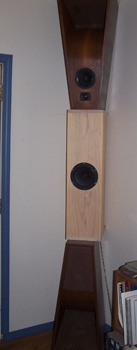 <br> the PS 180 has a better
<br> the PS 180 has a better
bass response and the 4.5 mm Xmass really helps the output>
to save some space!

bass response and the 4.5 mm Xmass really helps the output>
Last edited:
That's a pretty interesting folding scheme. I particularly like the last section of the enclosure, the connection to the corner. It's a bit Olson/Nagaoka/Scotmoose-like, but it also has a little Elevtrovoice Aristocrat thrown in. I have never seen them combined like this. Well done!
Regarding firing the whole range through a horn, there are precedents.
For instance, the basshorn of the Klipsch Jubilee reaches beyond 1kHz and I think I read at least one report that crossing over quite high gives acceptable response. If you read Bruce Edgar's Showhorn article, there is this bit about reflectors. With straght bends and 45 degree reflectors, the soundwaves can pass through a horn quite well. The Klipsch Jubilee is loaded with true woofers, not seriously intended for any range beyond that.
There are the Western Electric "big horns", driver by a compression driver. I don't recall their range exactly, but remember quotes from 125 Hz to 10 kHz. There was an interesting analysis of the success of these horns bij JMMLC on the Audio Asylum/High Efficiency, he posulated that the success was in the aspect ratio. The bends in the WE horns are in very narrow sections, making the difference between the inner and outer side of the bend very small, thereby reducing cancellation.
Look at these FEM-simulations by John Sheerin: Index of /images/roundbend. He shows some of the effects of bends, reflectors and width of the horn. Interesting stuff.
It seems to me, that by combining drivers that can have a wider range (more extended midrange and treble than the woofers in the Klipsch Jubilee and more bass capability than the compression driver in the WE horns) AND by specifically designing the horn to pass a wider range of frequencies, it may be possible to design a horn that at least does a lot better than we have seen up until now. I am thinking along the lines of a line array with small fullrange drivers, folded into a cabinet a bit like a Klipsch LaScala, or a Belle Klipsch.
So, who has a lot of tiny drivers, a good idea for the driver to horn mouth transition and some free time?
For instance, the basshorn of the Klipsch Jubilee reaches beyond 1kHz and I think I read at least one report that crossing over quite high gives acceptable response. If you read Bruce Edgar's Showhorn article, there is this bit about reflectors. With straght bends and 45 degree reflectors, the soundwaves can pass through a horn quite well. The Klipsch Jubilee is loaded with true woofers, not seriously intended for any range beyond that.
There are the Western Electric "big horns", driver by a compression driver. I don't recall their range exactly, but remember quotes from 125 Hz to 10 kHz. There was an interesting analysis of the success of these horns bij JMMLC on the Audio Asylum/High Efficiency, he posulated that the success was in the aspect ratio. The bends in the WE horns are in very narrow sections, making the difference between the inner and outer side of the bend very small, thereby reducing cancellation.
Look at these FEM-simulations by John Sheerin: Index of /images/roundbend. He shows some of the effects of bends, reflectors and width of the horn. Interesting stuff.
It seems to me, that by combining drivers that can have a wider range (more extended midrange and treble than the woofers in the Klipsch Jubilee and more bass capability than the compression driver in the WE horns) AND by specifically designing the horn to pass a wider range of frequencies, it may be possible to design a horn that at least does a lot better than we have seen up until now. I am thinking along the lines of a line array with small fullrange drivers, folded into a cabinet a bit like a Klipsch LaScala, or a Belle Klipsch.
So, who has a lot of tiny drivers, a good idea for the driver to horn mouth transition and some free time?

Very nice and elegant design.
One of the good things about corner speakers is that they do not take much area on the living room, compared to floorstanders, so they have high WAF. Bigger is better. Looking at the descending frequency response, I would (if I did not have my own design pending for years now) try:
1) A little front horn to increase midrange response and match the higher HF response.
2) Make the back horn longer to increase LF response.
3) Try to use the upper and lower corners of the room (instead of putting extra speakers there) modifying the exit of the horn, for bigger mouth area. BTW, adding a front horn alllows, or better urges, to make the back horn a little longer...
Hmmm...maybe I can get the Autographs from my mind...
Good luck.
M.
PS: hi Scott.
One of the good things about corner speakers is that they do not take much area on the living room, compared to floorstanders, so they have high WAF. Bigger is better. Looking at the descending frequency response, I would (if I did not have my own design pending for years now) try:
1) A little front horn to increase midrange response and match the higher HF response.
2) Make the back horn longer to increase LF response.
3) Try to use the upper and lower corners of the room (instead of putting extra speakers there) modifying the exit of the horn, for bigger mouth area. BTW, adding a front horn alllows, or better urges, to make the back horn a little longer...
Hmmm...maybe I can get the Autographs from my mind...
Good luck.
M.
PS: hi Scott.
That's a pretty interesting folding scheme. I particularly like the last section of the enclosure, the connection to the corner. It's a bit Olson/Nagaoka/Scotmoose-like, but it also has a little Elevtrovoice Aristocrat thrown in. I have never seen them combined like this. Well done!
Your right that it has never been done before, and this is,was the hardest part to the Klaushorn I have to admit that I check your link and I am very impressed what you have designed, I,m a amateur
compaired to your knowhow. Never the less I,m learned a lot on this build, the build I had before was not as hard, it was a Bushhorn design
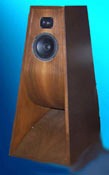
I sound is not quite as dynamic but when I installed the tweeter it is a very balanced sound.
thank you for your compliment, IVO
this is a new cornerhorn design!
Well, thank you for you input and there is a coincedent here when you mentioned the Autographs, been there and build one pair for the 6.5" fostex
I really like the looks of these Cabs. the sound was impressive too!
Thanks M.
Very nice and elegant design.
One of the good things about corner speakers is that they do not take much area on the living room, compared to floorstanders, so they have high WAF. Bigger is better. Looking at the descending frequency response, I would (if I did not have my own design pending for years now) try:
1) A little front horn to increase midrange response and match the higher HF response.
2) Make the back horn longer to increase LF response.
3) Try to use the upper and lower corners of the room (instead of putting extra speakers there) modifying the exit of the horn, for bigger mouth area. BTW, adding a front horn alllows, or better urges, to make the back horn a little longer...
Hmmm...maybe I can get the Autographs from my mind...
Good luck.
M.
PS: hi Scott.
Well, thank you for you input and there is a coincedent here when you mentioned the Autographs, been there and build one pair for the 6.5" fostex
An externally hosted image should be here but it was not working when we last tested it.
I really like the looks of these Cabs. the sound was impressive too!
Thanks M.
- Status
- This old topic is closed. If you want to reopen this topic, contact a moderator using the "Report Post" button.
- Home
- Loudspeakers
- Full Range
- This is a new cornerhorn design!
